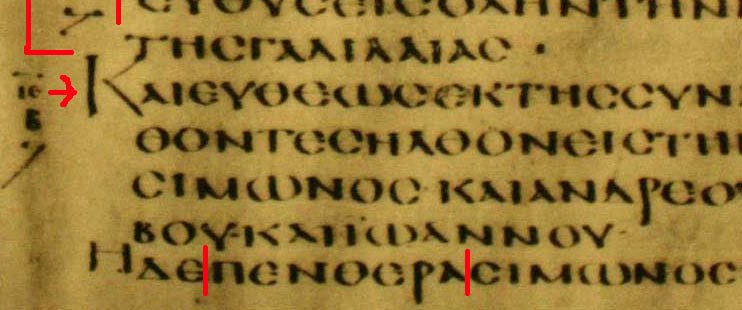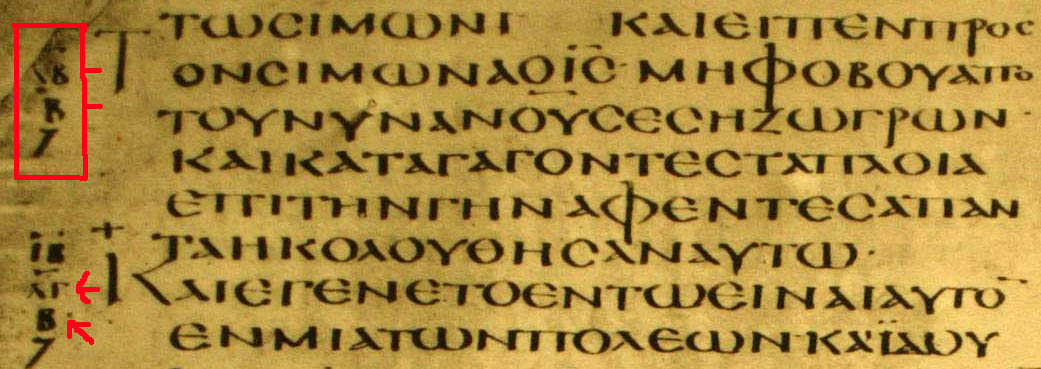
 |
Freethought & Rationalism ArchiveThe archives are read only. |
|
|
#61 | |
|
Veteran Member
Join Date: Jan 2005
Location: USA
Posts: 1,307
|
Quote:
Stephen |
|
|
|
|
|
#62 | |
|
Veteran Member
Join Date: Jun 2004
Location: none
Posts: 9,879
|
Quote:
|
|
|
|
|
|
#63 | |
|
Regular Member
Join Date: Mar 2006
Location: Michigan
Posts: 119
|
Quote:
Here is the corresponding τιτλος: Now which marginal notation corresponds to this and why? I am on this page |
|
|
|
|
|
#64 | |
|
Regular Member
Join Date: Mar 2006
Location: Michigan
Posts: 119
|
Quote:
corresponds to this blank space with what I think is an line over the character: This is Mark 1:40 και ερχεται προς αυτον λεπρος παρακαλων αυτον και γονυπετων αυτον και λεγων αυτω οτι εαν θελης δυνασαι με καθαρισαι or A man with leprosy came to him and begged him on his knees, "If you are willing, you can make me clean." |
|
|
|
|
|
#65 |
|
Banned
Join Date: Mar 2006
Location: 7th Heaven
Posts: 406
|
Good eye, Buster! That's what I've been trying to show through words up till now. Thanks for the pictures and pointers!
|
|
|
|
|
#66 | |
|
Banned
Join Date: Mar 2006
Location: 7th Heaven
Posts: 406
|
The images are fairly hard to read in your browser, so several of us probably just skimmed the intro. Here is a fairly important part that should help explain what Buster just pointed out:
Quote:
|
|
|
|
|
|
#67 | ||||
|
Banned
Join Date: Mar 2006
Location: 7th Heaven
Posts: 406
|
Quote:
Quote:
Quote:
Quote:
|
||||
|
|
|
|
#68 |
|
Banned
Join Date: Mar 2006
Location: 7th Heaven
Posts: 406
|
Ok. Here we go..... I have the first five kephalaia below:
α - περι του δαιμονιζομενου 1 - about the demon-possessed β - περι της πενθερας πετρου 2 - about the mother-in-law of Peter γ - περι των ιαθεντων απο ποικιλων νοσων 3 - about the healing from various illnesses δ - περι του λεπρου 4 - about the leper ε - περι του παραλυτικου 5 - about the paralytic The kephalaia begin on the first page of Mark in the second/right column. Before I post each of these 5 kephalaia, however, I'd like to point out one that confuses me. It is the very first one on the first page in the second column. It does not relate to anything in the table of kephalaia. I do not know what it is. Anyone? It is in the red box, does not appear to have an "underscore", and does not relate to anything in the table. What is it?  After looking at this puzzling sign, we'll start with the actual kephalaia.... α - περι του δαιμονιζομενου 1 - about the demon-possessed one  second/right column, 1st page: In the above image (and in subsequent images) I have put a box around the "7" sign and its "underscore" that indicate a kephalaion. The arrow simply points to the beginning of the section. This section of text is "about the demon-possessed one". β - περι της πενθερας πετρου 2 - about the mother-in-law of Peter  second/right column, 1st page: In the above image, not the "7" sign. However, unless it has worn away with time, there does not appear to be an "underscore" on this one! Nonetheless, this is definitely the section that talks about Peter's mother-in-law, as one can read between the brackets at the bottom of the image. γ - περι των ιαθεντων απο ποικιλων νοσων 3 - about the healing from various illnesses  first/left column, 2nd page: For the above image, the meaning of my red boxes and arrows should be fairly obvious by now. However, someone asked earlier about the "modern" verses (or whatever they are...) that are mentioned in the intro. I believe the "2" on the right side of this image is one of them. There is a "3" a page or two later in the middle margin. δ - περι του λεπρου 4 - about the leper  first/left column, 2nd page: Above, you can see the "7" sign's "underscore" repeated over the first letter of this section where the arrow is pointing at the right. This section is "about the leper" as you can read from between the brackets. ε - περι του παραλυτικου 5 - about the paralytic  second/right column, 2nd page: Finally, the above image is similar to the previous one where the horizontal sign is over the first letter of the section where the arrow is pointing. This section is "about the paralytic" as can be seen between the brackets at the bottom of the image. Everyone got something of a grasp on the kephalaia stuff now? |
|
|
|
|
#69 |
|
Banned
Join Date: Mar 2006
Location: 7th Heaven
Posts: 406
|
Others have have already pointed out how the Eusebian reference works, but I looked up one of the sections. In a previous image, I pointed out one of the Eusebian references in Mark, specifically ι/β (10/2) found in the center margin of the first page of Mark.
 Again, the bottom number, 2, is the Eusebian cannon/table to look at, and the top number, 10, is what you will look for under the column for the book of Mark. So, if one looks at the Eusebian Canon number 2 (II), finds 10, and looks horizontally across to the column for the book of Luke, they will see the number 32. Now comes the fun part, turning this back into Greek numbers so that we can look up the reference in the actual text. I'll make it easy on you since I've already done the leg work.  The reference 32/2 in Greek numerals would be λβ/β. The reference 32/2 in Greek numerals would be λβ/β.At this point, we flip over to the book of Luke and start a hunt for this reference. The numbers go in order, but don't get tripped up by the fact that there are 10 canons. That means there will be other references to confuse you. Skip over every reference that does not have a beta, β, on the bottom. Eventually, after much eyestrain, you will find the synoptic parallel between Mark and Luke. It can be found on this page (27a). Below is a picture of it.  The reference can be seen inside the red box, although part of the page is torn/missing. Across from the upper "tick mark" on the right side of the box, you will see the lower right portion of the lamba's (λ) leg and then the beta (β). Across from the lower "tick mark" is the beta (β) representing the specific Eusebian Canon. So, this is the Lukan parallel to the portion of Mark at which we were looking. The two arrows at the bottom are simply pointing to the next Eusebian reference. As you can see, the top number is the next in sequential order. Helpful? This was a fun exercise for me. I have to say it was much, much easier to do in the Nestle-Aland 27th Ed. of the Greek New Testament!! |
|
|
|
|
#70 |
|
Banned
Join Date: Mar 2006
Location: 7th Heaven
Posts: 406
|
After this weekend, I will try to get into some differences between the text of Codex Alexandrinus and Sinaiticus (Aleph), Vaticanus (B), and/or Bezae (D). After browsing through the text, it didn't seem like there was much worth noting (at least in the early pages of Mark) with respect to differences between Alexandrinus and the Textus Receptus, so I think I'll let that comparison go.
If anyone else has anything to add, go head. Any more questions? Ask 'em! Just want to think out loud about this stuff? Go ahead! |
|
|
| Thread Tools | Search this Thread |
|